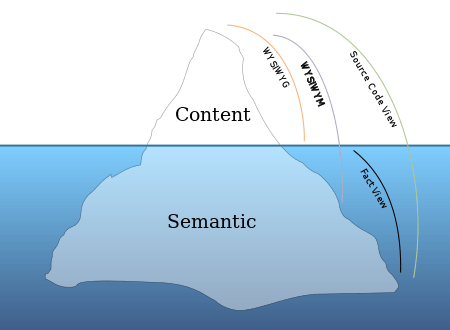WYSIWYM

WYSIWYM /ˈwɪziwɪm/ (an acronym for "what you see is what you mean") is a paradigm for editing a structured document. It is an adjunct to the better-known WYSIWYG (what you see is what you get) paradigm, which displays a formatted document on screen as it will appear in only one mode of presentation.
In a WYSIWYM editor, the user writes the contents in a structured way, marking the content according to its meaning, its significance in the document, leaving its final appearance up to one or more separate style sheets. For example, in a WYSIWYM document a human being manually marks text as the title of the document, the name of a section, or the name of an author; this would in turn allow one element, such as section headings, to be rendered as large bold text in one style sheet, or as red center justified text in another, without further human intervention. This requires the semantic structure of the document to be decided on before writing it. The editor also needs a system for exporting structured content to generate the document's final format, following the indicated structure.
The main advantage of this system is the total separation of presentation and content: users can structure and write the document once, rather than repeatedly altering it for each mode of presentation, which is left to the export system.
Document processors
Unlike a fixed-presentation unstructured document, a document processor rather than a word processor must be used for WYSIWYM. The first document processor which articulated[1] itself through WYSIWYM term was LyX document processor although similar concepts can be traced back to much earlier publishing systems like TPS, itself modelled on pioneering experiments at Xerox PARC, the most popular probably being FrameMaker.
For example, in FrameMaker, a document may be authored (i.e., viewed and edited) using two possible page views, the styling tags (called “formats”) and contents of a document reside in “body pages”, while structure and presentation are defined by “master pages”.[lower-alpha 1] Multiple such documents can be linked together and programmed conditionally for a variety of applications. These elements can then be exported to corresponding tags which preserve some or all of their functionality in a markup language such as XML/HTML/CSS and PDF, or directly rendered down for final presentation in anything from PostScript to raw text.
In web environments
Major software vendors have integrated web-page creation features into their popular WYSIWYG products to increase their utility. Users can create an HTML web page in a word processor with no knowledge of HTML, but like nearly all IDE authored or handwritten web markup, these tools' automated analysis of the source format rarely account for nor offer a distinction between HTML's content and its presentation through means such as CSS during output.
Such fixed-presentation HTML generators have been criticized, primarily because of the bloatedness and low quality of their code,[3][4][5] and there are voices advocating changing to the WYSIWYM model.[6][7][8]
One example of a WYSIWYM Web page editor is WYMeditor.[9] In this editor the structure of the documents is defined by the class attributes of HTML elements. These classes also allow the final appearance of the document to be applied. Although WYMeditor follows a WYSIWYM model, the document format is always HTML, so the new structures to be defined are limited to new classes. And the final document will always be built by applying presentational elements to these classes.
Other CMS are moving into the direction of providing some WYSIWYM interface for their users editing content. Tiki Wiki CMS/Groupware version 7.0[10] is one of them, by means of using CodeMirror in-browser editing software. Also Doctored.js is an open source XML editor with a WYSIWYM interface.
See also
Notes
- ↑ Strictly speaking, this explanation of FrameMaker's page views applies only to so-called ”unstructured documents”. These page views are not to be confused with the commonly known FrameMaker modes used for authoring different types of documents. The mode for unstructured documents is called "Unstructured FrameMaker" or simply "FrameMaker" whereas the mode for the so-called ”structured documents” is called ”Structured FrameMaker”. Starting from FrameMaker 12, it also offers a third mode, called ”FrameMaker XML Author”.[2]
References
- ↑ http://www.mail-archive.com/[email protected]/msg00011.html
- ↑ http://help.adobe.com/en_US/FrameMaker/12.0/Help/Using/index.html#t=using-framemaker-12%2Ffrm_getstarted_gs%2Ffrm_getstarted_gs-3.htm
- ↑ Sauer, C.: WYSIWIKI - Questioning WYSIWYG in the Internet Age. In: Wikimania (2006)
- ↑ Spiesser, J., Kitchen, L.: Optimization of html automatically generated by WYSIWYG programs. In: 13th International Conference on World Wide Web, pp. 355-364. WWW '04. ACM, New York, NY (New York, NY, USA, May 17–20, 2004)
- ↑ de Vries, D.J. (2010-10-29). "RenovatioCMS - An innovative view". Retrieved 2010-10-29.
- ↑ Roger Johansson. "456BereaStreet". 456BereaStreet. Retrieved 2012-08-02.
- ↑ Peter Krantz (2006-12-05). "standards-schmandards". standards-schmandards. Retrieved 2012-08-02.
- ↑ "Thom Shannon's blog". Ts0.com. 2007-09-19. Retrieved 2012-08-02.
- ↑ "WYMeditor: web-based XHTML editor". Retrieved 27 May 2011.
- ↑ "Tiki7". Doc.tiki.org. 2012-04-22. Retrieved 2012-08-02.
External links
- RDFaCE - an open source RDFa Editor based upon the WYSIWYM principle
- RenovatioCMS - A free and open source content management system based upon the WYSIWYM principle
- WYMeditor - Standards compliant open source WYSIWYM web-based editor
- Extension:MeanEditor - An extension for Mediawiki providing a WYSIWYM editor based on WYMeditor
- LyX - LyX, a WYSIWYM document processor.
- scenari-platform.org - Scenari, a WYSIWYM XML-based editing and publishing Open Source software (last update in 2007)
- VHWX - Vigorous Hive WYSIWYM editor for XML
- jquery-wysiwym - A free simple WYSIWYM editor.
- Texts - Markdown WYSIWYM editor for Windows and Mac OS X.